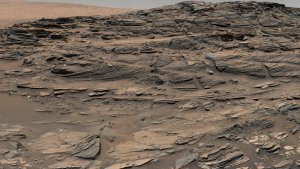Space News

Some of the dark sandstone in an area being explored by NASA's Curiosity Mars rover shows texture and inclined bedding structures characteristic of deposits that formed as sand dunes, then were cemented into rock. »
NASA's Cassini spacecraft will zip past Saturn's moon Dione on Monday, Aug. 17, the final close flyby of this icy satellite during the spacecraft's long mission. »
Like graffiti sprayed by an unknown artist, unexplained arc-shaped, reddish streaks are visible on the surface of Saturn's icy moon Tethys. »
Kepler mission has confirmed the first near-Earth-size planet in the "habitable zone" around a sun-like star. »
NASA's Curiosity Mars rover has found a target unlike anything it has studied before -- bedrock with surprisingly high levels of silica. Silica is a rock-forming compound containing silicon and oxygen, commonly found on Earth as quartz. »
A newly discovered mountain range lies near the southwestern margin of Pluto’s Tombaugh Regio (Tombaugh Region), situated between bright, icy plains and dark, heavily-cratered terrain. »
In the latest data from NASA’s New Horizons spacecraft, a new close-up image of Pluto reveals a vast, craterless plain that appears to be no more than 100 million years old, and is possibly still being shaped by geologic processes. »
New close-up images of a region near Pluto’s equator reveal a giant surprise: a range of youthful mountains rising as high as 11,000 feet (3,500 meters) above the surface of the icy body. »
While busily investigating bedrock types on Mars' Mount Sharp and preparing for a drill test, NASA's Curiosity Mars rover has also been looking up frequently to monitor sunspots on the face of the sun that is turned away from Earth. »
After a more than nine-year, three-billion-mile journey to Pluto, it’s show time for NASA’s New Horizons spacecraft, as the flyby sequence of science observations is officially underway. »
What color is Pluto? The answer, revealed in the first maps made from New Horizons data, turns out to be shades of reddish brown. Although this is reminiscent of Mars, the cause is almost certainly very different. »
Saturn's moon Titan is home to seas and lakes filled with liquid hydrocarbons, but what forms the depressions on the surface? A new study using data from the joint NASA and the European Space Agency Cassini mission suggests the moon's surface dissolves in a process that's similar to the creation of sinkholes on Earth. »
Researchers using data from NASA's Spitzer Space Telescope propose that warm Neptune-size planets with clouds of helium may be strewn about the galaxy by the thousands. »
Astronomers have used NASA’s Chandra X-ray Observatory to show that, multiple eruptions from a supermassive black hole over 50 million years have rearranged the cosmic landscape at the center of a group of galaxies. »
Most galaxies are clumped together in groups or clusters. A neighboring galaxy is never far away. But this galaxy, known as NGC 6503, has found itself in a lonely position, at the edge of a strangely empty patch of space called the Local Void. »
NASA's Mars Reconnaissance Orbiter has detected deposits of glass within impact craters on Mars. Though formed in the searing heat of a violent impact, such deposits might provide a delicate window into the possibility of past life on the Red Planet. »
NASA's Cassini spacecraft will make its final close approach to Saturn's large, irregularly shaped moon Hyperion on Sunday, May 31. »
Visible Martian aurorae seemed possible after the SPICAM imaging instrument on-board the ESA satellite Mars Express spotted aurorae from space in 2005. Those observations were confirmed in March 2015 by the NASA-led MAVEN mission. »
Astronomers using NASA's Hubble Space Telescope have uncovered surprising new clues about a hefty, rapidly aging star whose behavior has never been seen before in our Milky Way galaxy. »

A remote galaxy shining with the light of more than 300 trillion suns has been discovered using data from NASA's Wide-field Infrared Survey Explorer (WISE). The galaxy is the most luminous galaxy found to date and belongs to a new class of objects recently discovered by WISE -- extremely luminous infrared galaxies, or ELIRGs. »

MAVEN spacecraft detected evidence of widespread auroras in Mars's northern hemisphere. The "Christmas Lights," as researchers called them, circled the globe and descended so close to the Martian equator that, if the lights had occurred on Earth, they would have been over places like Florida and Texas. »

NASA's Curiosity Mars rover recorded this view of the sun setting at the close of the mission's 956th Martian day, or sol, from the rover's location in Gale Crater. »
New research using data from NASA's Cassini mission suggests most of the eruptions from Saturn's moon Enceladus might be diffuse curtains rather than discrete jets. Many features that appear to be individual jets of material erupting along the length of prominent fractures in the moon's south polar region might be phantoms created by an optical illusion, according to the new study. »

Four men trapped under as much as 10 feet of bricks, mud and other debris have been rescued in Nepal thanks to a new search-and-rescue technology developed in partnership by DHS, S&T and NASA/JPL. »
A NASA planetary exploration mission came to a planned, but nonetheless dramatic, end Thursday when it slammed into Mercury’s surface at about 8,750 mph and created a new crater on the planet’s surface. »
After extraordinary science findings and technological innovations, a NASA spacecraft launched in 2004 to study Mercury will impact the planet’s surface, most likely on April 30, after it runs out of propellant. »
Long, sinuous, tendril-like structures seen in the vicinity of Saturn's icy moon Enceladus originate directly from geysers erupting from its surface, according to scientists studying images from NASA's Cassini spacecraft. »
Martian weather and soil conditions that NASA's Curiosity rover has measured, together with a type of salt found in Martian soil, could put liquid brine in the soil at night. »
The long-standing mystery of why Saturn seethes with enormous storms every 30 years may have been solved by scientists. The tempests, which can grow into bright bands that encircle the entire planet, are on a natural timer that is reset by each subsequent storm. »
Two-tone mineral veins at a site NASA's Curiosity rover has reached by climbing a layered Martian mountain offer clues about multiple episodes of fluid movement. These episodes occurred later than the wet environmental conditions that formed lake-bed deposits the rover examined at the mountain's base. »
A dual view of Saturn's icy moon Rhea marks the return of NASA's Cassini spacecraft to the realm of the planet's icy satellites. This follows nearly two years during which the spacecraft's orbits carried it high above the planet's poles. Those paths limited the mission's ability to encounter the moons, apart from regular flybys of Titan. »
A team using the Sample Analysis at Mars (SAM) instrument suite aboard NASA's Curiosity rover has made the first detection of nitrogen on the surface of Mars from release during heating of Martian sediments. »
Mars Exploration Rover Opportunity completed its first Red Planet distance on March 24, 2015 - 42.195 kilometers - with a finish time of roughly 11 years and two months. »
Using Stratospheric Observatory for Infrared Astronomy, an international scientific team discovered that supernovae are capable of producing a substantial amount of the material from which planets like Earth can form. »
Hubble Space Telescope has the best evidence yet for an underground saltwater ocean on Ganymede, Jupiter’s largest moon. The subterranean ocean is thought to have more water than all the water on Earth's surface. »


